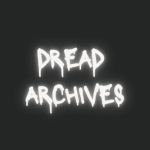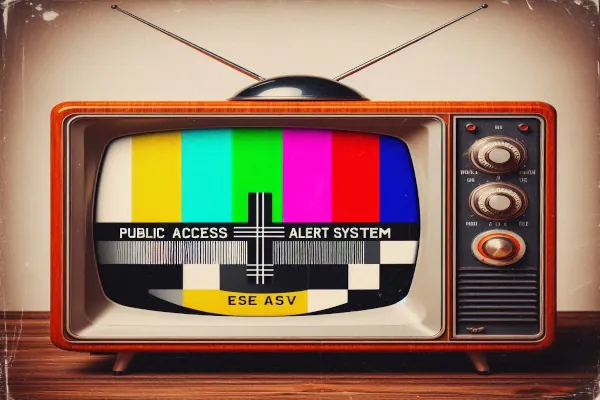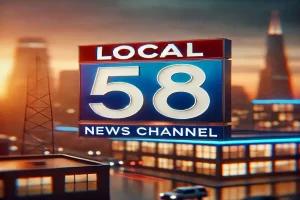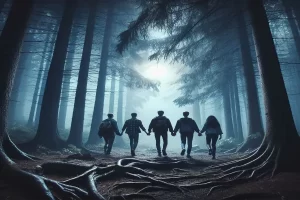There’s something deeply unsettling about the look and feel of old public access TV. The grainy visuals, awkward edits, and eerily cheerful hosts create an uncanny atmosphere, making it the perfect aesthetic for horror. Originally designed as community-driven, low-budget programming, public access TV has evolved into an unexpected source of inspiration for modern horror media. Its amateur production values and raw authenticity evoke a sense of nostalgia, but also unease—almost as if there’s something hidden beneath the surface, waiting to be uncovered.
In recent years, horror creators have leaned into this aesthetic, repurposing its visual and audio style to deliver spine-chilling stories. From analogue horror series to found footage films, the low-budget charm of public access TV now amplifies tension and fear in entirely new ways. But why does this aesthetic work so well? What is it about those glitchy visuals and distorted audio that gets under our skin? Let’s dive into how public access aesthetics transform the ordinary into the terrifying, giving us nightmares through a lens of distorted familiarity.
What Are Public Access Aesthetics?
Defining Public Access Aesthetics
Public access television, often seen as a relic of the late 20th century, was originally created to give communities a voice through locally produced, low-budget programming. Its charm lies in its amateur quality: grainy visuals, awkwardly composed shots, poor lighting, and unsophisticated editing. These features created a distinct aesthetic characterized by static interruptions, low resolution, and an offbeat, unpolished pacing. From cooking shows to niche hobby programs, public access TV embodied raw authenticity, but its imperfections have since become a canvas for unsettling creativity in modern horror.
In horror, these traits—once innocent and utilitarian—are deliberately used to evoke unease. The lack of polish feels unnervingly real, as if what you’re watching wasn’t meant for your eyes. This aesthetic taps into our subconscious, making the mundane feel uncanny and the comforting seem sinister.
The Nostalgia Factor and Uncanny Appeal
For many, public access aesthetics carry a nostalgic pull, evoking memories of simpler times when grainy TV screens dominated living rooms. However, this nostalgia is double-edged. The dated production values, once a source of charm, now trigger discomfort when paired with eerie or unsettling content. The familiar becomes warped, pulling viewers into the uncanny valley where something feels slightly “off” but is difficult to pinpoint.
By blending this sense of nostalgia with horror, creators amplify tension and fear. A cheerful children’s program distorted with glitches, or a friendly host replaced with something sinister, taps into the primal fear of innocence corrupted. It’s this delicate balance of familiarity and distortion that makes public access aesthetics so uniquely terrifying.
The Psychological Impact of Low-Fidelity Media
The Unsettling Power of Imperfection
There’s something inherently disquieting about imperfection in media, especially when it’s unintentional—or appears to be. Public access aesthetics, with their low resolution, awkward editing, bad lighting, and distorted audio, create an atmosphere of unease by disorienting the viewer. These technical flaws, far from being mere quirks, disrupt the polished norms of modern media, making the audience question the reliability of what they’re seeing.
This discomfort arises because humans are hardwired to detect patterns and anticipate smooth, coherent visuals and sounds. When those patterns are broken—through glitches, static, or abrupt cuts—it signals to the brain that something is wrong. This lack of clarity or polish triggers a sense of vulnerability, leaving viewers uneasy as they subconsciously prepare for something unexpected to occur.
Amplifying the Fear of the Unknown
Low-fidelity media’s amateurish appearance also blurs the line between reality and fiction, a hallmark of analogue and public access horror. Its authenticity mimics real-life imperfections so convincingly that it lulls viewers into believing they are watching something genuine. This believability makes it even more unsettling when the content takes a dark or disturbing turn. The cognitive dissonance between the familiar (a grainy PSA or children’s show) and the sinister (distorted audio, glitchy figures, or cryptic messages) amplifies the fear of the unknown.
By leveraging low-budget techniques, creators tap into a primal fear: the sense that what you’re witnessing was not meant to be seen. Whether it’s an old VHS tape with cryptic edits or an awkwardly cheerful host delivering increasingly sinister messages, the lack of polish reinforces the horror. The flaws aren’t just part of the aesthetic; they are essential tools that amplify tension, making viewers question what’s real and what lies beneath the surface of the flawed media they’re consuming.
The Role of Public Access Aesthetics in Analogue Horror
The Intersection of Public Access and Analogue Horror
Analogue horror series like Local 58 and Gemini Home Entertainment expertly use public access aesthetics to craft unnerving experiences. These shows draw heavily on the visual and auditory language of low-budget television, mimicking the style of 1980s and 1990s public access programming. This includes grainy visuals, low-resolution broadcasts, distorted audio, awkward transitions, and static interruptions—all of which set the stage for something far darker than a typical program would suggest.
By tapping into this aesthetic, analogue horror creators evoke the feeling of watching a “forgotten” broadcast or something that was never meant to be seen by the public eye. The familiar, everyday nature of public access programming lulls the viewer into a false sense of security, only to disrupt it with increasingly bizarre, disturbing, and even terrifying content. This unsettling blend of nostalgia and horror creates a profound psychological tension. The viewer is lulled into the comfort of familiarity only for that safety to be ripped away, revealing a hidden darkness behind mundane, harmless imagery.
The Eerie Familiarity of Public Access
One of the most effective tools in analogue horror is its ability to twist “familiar horror” into something truly frightening. Public access aesthetics inherently evoke a sense of nostalgia—a connection to the past, to childhood memories of late-night TV or local programming. Shows in the 1980s and 1990s would often be rough around the edges, poorly edited, and feature unscripted moments of awkwardness. This familiarity offers a baseline of normalcy that these analogue horror series skillfully manipulate.
When the series begin with a program that feels familiar—perhaps a weather update, a children’s show, or an educational broadcast—the viewer feels safe and at ease. However, as the plot progresses, the previously normal setting becomes increasingly unsettling. The host’s smile falters, the content becomes erratic, and strange, cryptic messages begin to appear. The deliberate use of this “familiar horror” amplifies the terror because it plays on our deep-rooted recognition of old TV, only to subvert it into a nightmare. The uncanny aspect is key—viewers can’t quite place why it feels so wrong, but they know it’s deeply unsettling.
Public Access Aesthetics and the Creation of Unnatural Normalcy
The “Invasion of the Familiar”
Public access aesthetics are masterful in establishing a false sense of normalcy. The rough, low-budget look of these broadcasts—grainy visuals, fuzzy audio, and awkward pacing—was once a staple of everyday life, especially in the 1980s and 1990s. For many, public access TV represented a familiar, local, and accessible form of entertainment. The programming, often amateur in nature, could include anything from educational content to local news broadcasts, and while it might be imperfect, it still had a sense of reliability.
However, in the realm of horror, these same aesthetics are turned on their head. When we watch analogue horror through the lens of public access aesthetics, the seemingly harmless or everyday moments quickly take on a darker tone. A seemingly benign local broadcast suddenly becomes an invitation for something far more sinister. The idea that the familiar can be violated by something horrific amplifies the sense of dread—because if something as ordinary as public access programming can hide something terrifying, what else can? The intrusion of the horrifying into a normal, relatable space creates a dissonance that is deeply unsettling.
Breaking the Fourth Wall with Outdated Technology
The use of outdated media, such as VHS tapes or CRT TVs, enhances the sense of distance between the viewer and the present. These older technologies are relics of a time long past, and when they appear in a horror context, they evoke feelings of nostalgia mixed with unease. Public access programming, once broadcast through these technologies, often featured the imperfections of the medium—glitches, static, and occasional flickers. In horror, these imperfections are no longer just technical errors; they contribute to a sense of forgotten, abandoned media.
Older technology inherently creates a sense of alienation and vulnerability. The viewer knows that modern, polished media doesn’t look or feel like this—this is a connection to the past, a world where technology wasn’t as reliable or controlled as it is today. In the context of horror, this imperfection serves to break the fourth wall, making the audience feel as though they are interacting with something that has been left behind. These imperfections draw the viewer in, not as an observer of polished, highly produced content, but as a witness to something buried in the past—a moment that shouldn’t be revisited, yet is hauntingly present. This sense of distrust and detachment from modern media makes the horrors within these tapes feel more raw, real, and dangerously close to reality.
Conclusion
Public access aesthetics play a pivotal role in amplifying unease within horror, tapping into the unsettling atmosphere of low-tech, imperfect realism. The grainy visuals, distorted audio, and unpolished production values that once made public access television a fixture of everyday life now serve as the perfect vehicle for terror. These elements create an atmosphere where what seems familiar becomes deeply unnerving, blurring the lines between the real and the unreal.
The eerie familiarity of public access aesthetics allows horror stories to sneak under the viewer’s radar, playing on the comfort of nostalgia before flipping it into a terrifying, distorted reality. As audiences watch these outdated broadcasts, they are reminded of a time when the boundaries of what was possible with media were much more fluid—leaving room for the suggestion that the horrors presented in these tapes could be more than fiction.
If you haven’t already, dive into modern analogue horror series that use public access aesthetics, check out our post about Analogue Horror Series if you’d like to know more




